Paper Menu >>
Journal Menu >>
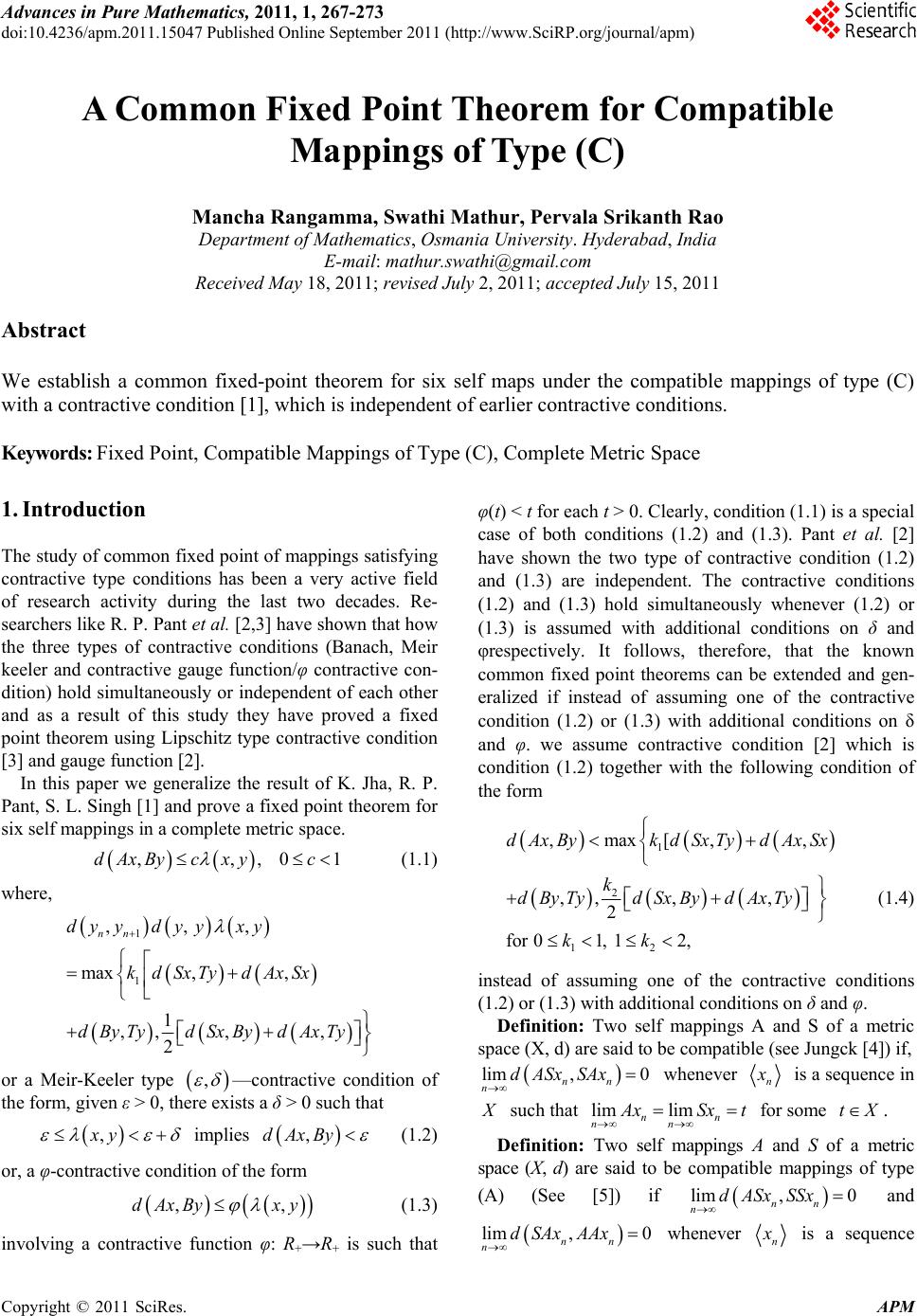 Advances in Pure Mathematics, 2011, 1, 267-273 doi:10.4236/apm.2011.15047 Published Online September 2011 (http://www.SciRP.org/journal/apm) Copyright © 2011 SciRes. APM A Common Fixed Point Theorem for Compatible Mappings of Type (C) Mancha Rangamma, Swathi Mathur, Pervala Srikanth Rao Department of Mathematics, Osmania University. Hyderabad, India E-mail: mathur.swathi@gmail.com Received May 18, 2011; revised July 2, 2011; accepted July 15, 2011 Abstract We establish a common fixed-point theorem for six self maps under the compatible mappings of type (C) with a contractive condition [1], which is independent of earlier contractive conditions. Keywords: Fixed Point, Compatible Mappings of Type (C), Complete Metric Space 1. Introduction The study of common fixed point of mappings satisfying contractive type conditions has been a very active field of research activity during the last two decades. Re- searchers like R. P. Pant et al. [2,3] have shown that how the three types of contractive conditions (Banach, Meir keeler and contractive gauge function/φ contractive con- dition) hold simultaneously or independent of each other and as a result of this study they have proved a fixed point theorem using Lipschitz type contractive condition [3] and gauge function [2]. In this paper we generalize the result of K. Jha, R. P. Pant, S. L. Singh [1] and prove a fixed point theorem for six self mappings in a complete metric space. ,,,0dAxByc xyc 1 (1.1) where, 1 1 ,, , max ,, 1 ,, ,, 2 nn dy ydyyxy kdSxTy dAxSx dByTydSxBy dAxTy or a Meir-Keeler type , —contractive condition of the form, given ε > 0, there exists a δ > 0 such that ,xy implies ,dAxBy (1.2) or, a φ-contractive condition of the form ,dAxBy xy , (1.3) involving a contractive function φ: R+→R+ is such that φ(t) < t for each t > 0. Clearly, condition (1.1) is a special case of both conditions (1.2) and (1.3). Pant et al. [2] have shown the two type of contractive condition (1.2) and (1.3) are independent. The contractive conditions (1.2) and (1.3) hold simultaneously whenever (1.2) or (1.3) is assumed with additional conditions on δ and φrespectively. It follows, therefore, that the known common fixed point theorems can be extended and gen- eralized if instead of assuming one of the contractive condition (1.2) or (1.3) with additional conditions on δ and φ. we assume contractive condition [2] which is condition (1.2) together with the following condition of the form 1 2 12 ,max[,, ,,,, 2 for 01, 12, dAxBykdSxTy dAxSx k dByTydSxBy dAxTy kk (1.4) instead of assuming one of the contractive conditions (1.2) or (1.3) with additional conditions on δ and φ. Definition: Two self mappings A and S of a metric space (X, d) are said to be compatible (see Jungck [4]) if, lim ,0 nn nd ASxSAx whenever n x is a sequence in X such that lim lim nn nn A xSx t for some tX . Definition: Two self mappings A and S of a metric space (X, d) are said to be compatible mappings of type (A) (See [5]) if lim ,0 nn ndASxSSx and lim ,0 nn nd SAxAAx whenever n x is a sequence 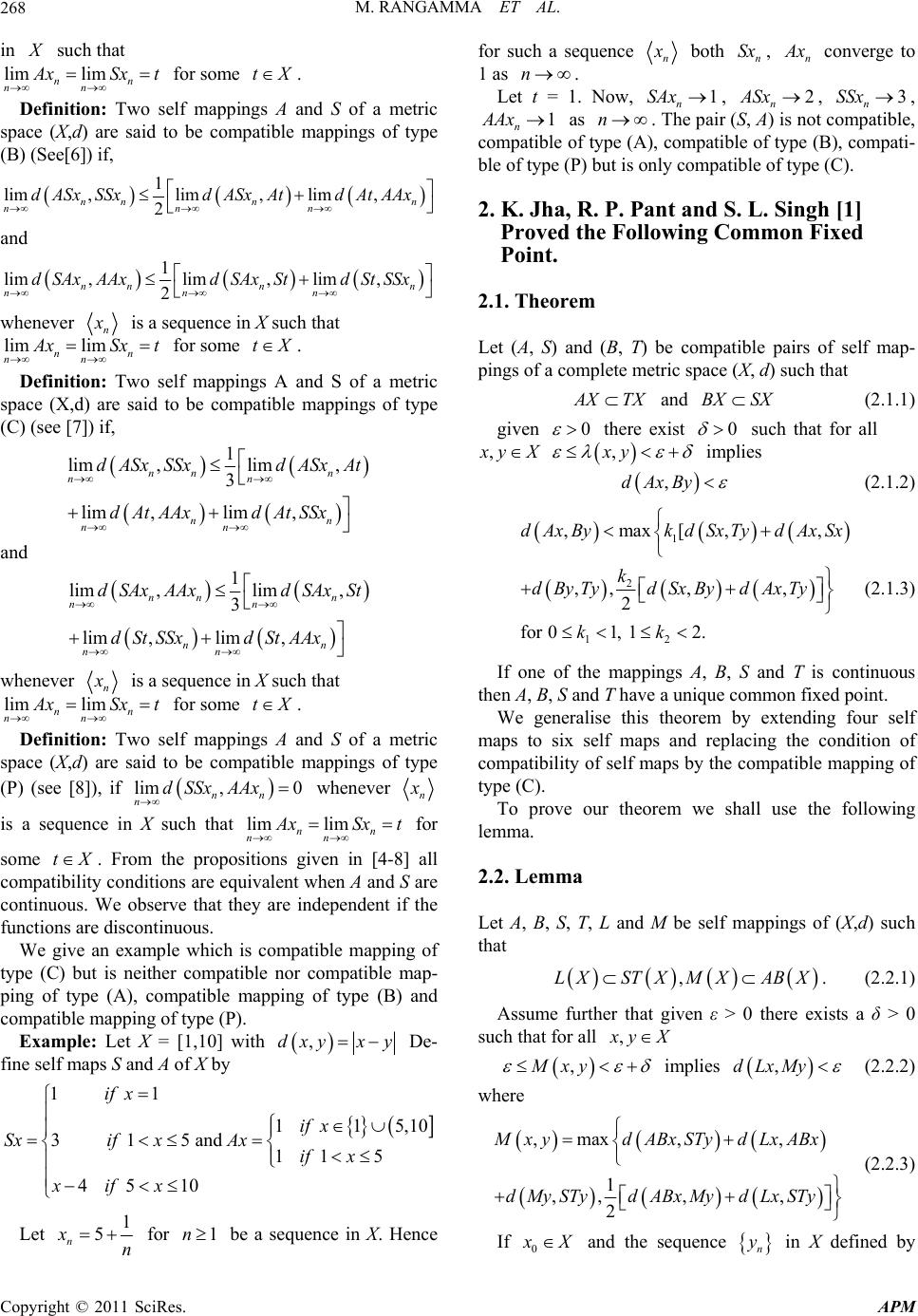 M. RANGAMMA ET AL. 268 in X such that li lim nn nn m A xSx t for some t. X Definition: Two self mappings A and S of a metric space (X,d) are said to be compatible mappings of type (B) (See[6]) if, , n x At 1 li,limlim , 2 nn n nnn ASxSSxdASdAtAAx md and , n x St 1 li,limlim , 2 nn n nnn SAxAAxdSAdSt SSx md whenever n x is a sequence in X such that li lim nn nn m A xSx t for some t. X Definition: Two self mappings A and S of a metric space (X,d) are said to be compatible mappings of type (C) (see [7]) if, li lim, nn d dAt 1 lim, m, 3 lim, nn n nn nn d ASxSSxASxAt dAtAAx SSx and lim m, nn d dSt A 1 lim ,, 3 lim, li nn n nn nn dSAxAAxSAxSt dSt SSxAx whenever n x is a sequence in X such that li lim nn nn m A xSx t for some t. X 0 nn Ax Definition: Two self mappings A and S of a metric space (X,d) are said to be compatible mappings of type (P) (see [8]), if whenever lim , ndSSx A n x is a sequence in X such that lim lim nn nn A xSx t for some . From the propositions given in [4-8] all compatibility conditions are equivalent when A and S are continuous. We observe that they are independent if the functions are discontinuous. tX We give an example which is compatible mapping of type (C) but is neither compatible nor compatible map- ping of type (A), compatible mapping of type (B) and compatible mapping of type (P). Example: Let X = [1,10] with ,dx d yxy De- fine self maps S and A of X by 1 1 1 15,10 3 15 an 1 15 4 510 ifx ifx Sxif xAxifx xifx Let 1 5 n xn for be a sequence in X. Hence 1n for such a sequence n x both , n Sx n A x converge to 1 as . n Let t = 1. Now, , , , as . The pair (S, A) is not compatible, compatible of type (A), compatible of type (B), compati- ble of type (P) but is only compatible of type (C). 1 n SAx 2 n ASx 3 n SSx 1 n AAx n 2. K. Jha, R. P. Pant and S. L. Singh [1] Proved the Following Common Fixed Point. 2.1. Theorem Let (A, S) and (B, T) be compatible pairs of self map- pings of a complete metric space (X, d) such that A XTX and (2.1.1) BX SX given 0 there exist 0 such that for all , x yX ,xy implies ,dAxBy (2.1.2) 1 2 12 ,max[,, ,, ,, 2 for 01, 12. dAxBykdSxTy dAxSx k dByTydSxBy dAxTy kk (2.1.3) If one of the mappings A, B, S and T is continuous then A, B, S and T have a unique common fixed point. We generalise this theorem by extending four self maps to six self maps and replacing the condition of compatibility of self maps by the compatible mapping of type (C). To prove our theorem we shall use the following lemma. 2.2. Lemma Let A, B, S, T, L and M be self mappings of (X,d) such that ,LXSTXMXABX . (2.2.1) Assume further that given ε > 0 there exists a δ > 0 such that for all , x yX ,Mxy implies ,dLxMy (2.2.2) where ,max ,, 1 ,, ,, 2 M xydABx STydLxABx dMySTydABxMy dLxSTy (2.2.3) If 0 x X and the sequence n y in X defined by Copyright © 2011 SciRes. APM 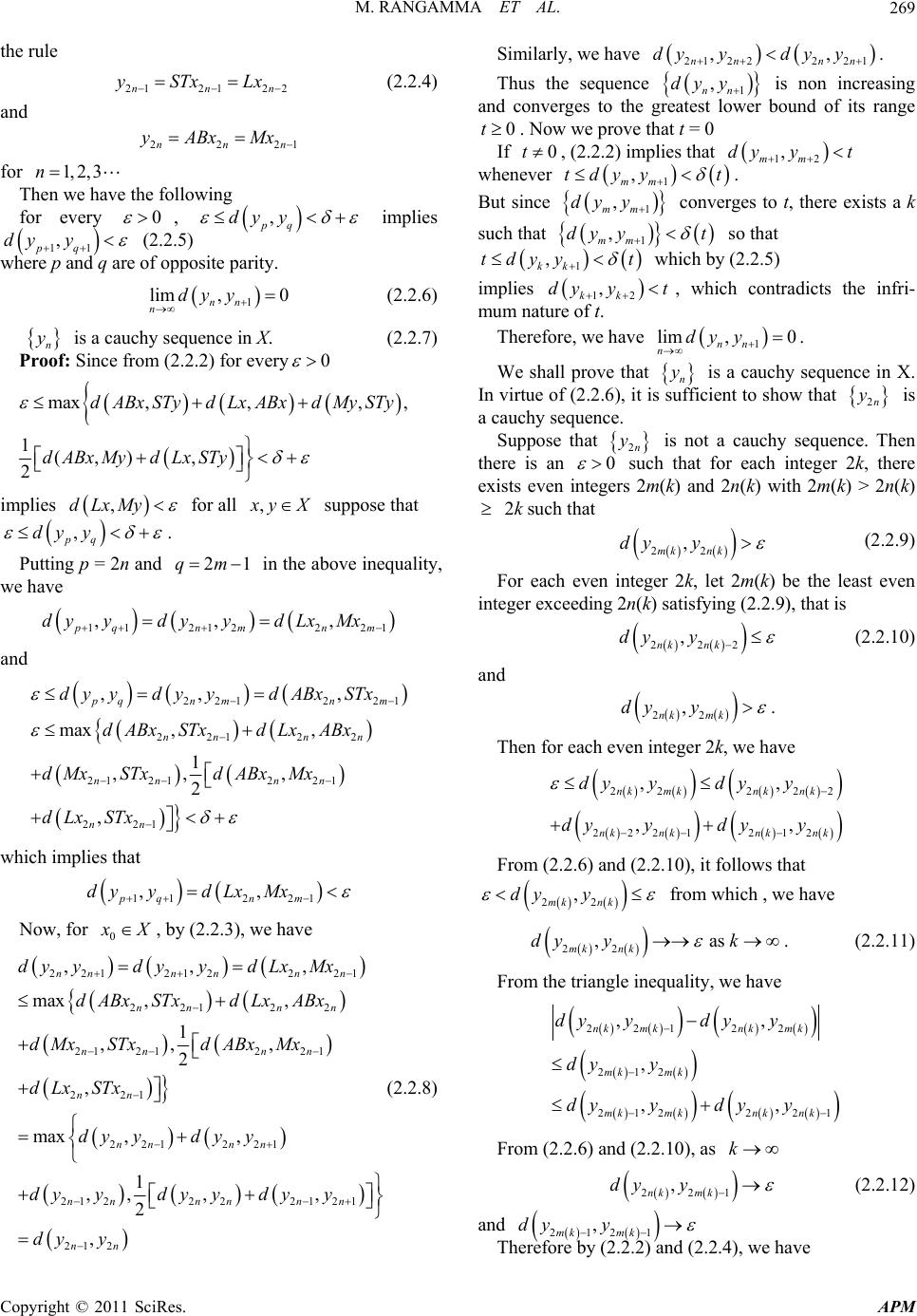 M. RANGAMMA ET AL.269 n 21n the rule 2121 22nn ySTxLx (2.2.4) and 22nn yABxMx for 1, 2,3n Then we have the following for every 0 , , pq dy y implies , pq dy y 11 where p and q are of opposite parity. (2.2.5) 1 lim ,0 nn ndy y (2.2.6) n y is a cauchy sequence in X. (2.2.7) Proof: Since from (2.2.2) for every0 max,,, , 1(,), 2 dABx STydLxABxdMy STy dABxMydLxSTy implies ,dLxMy for all , x yX suppose that ,y pq dy . Putting p = 2n and in the above inequality, we have 2qm1 112122 21 ,,, pqn mnm dyydyydLxMx and 2212 21 2212 2 21 21221 221 ,, , max ,, 1 ,, , 2 , pqn mnm nnn n nn nn nn dy ydyydABxSTx dABxSTxd LxABx d MxSTxdABxMx dLx STx which implies that 112 21 ,, pqn m dyydLxMx Now, for 0 x X, by (2.2.3), we have Similarly, we have 21 22221 ,, nn nn dyydyy . Thus the sequence 1 , nn dy y is non increasing and converges to the greatest lower bound of its range . Now we prove that t = 0 0t If 0t , (2.2.2) implies that 12 , mm dy yt whenever 1 , mm tdyy t. But since ,dy y1mm converges to t, there exists a k such that 1 , mm dy yt so that y t 1 , kk tdy which by (2.2.5) implies 12 , kk dy yt , which contradicts the infri- mum nature of t. Therefore, we have . 1 lim ,0 nn ndy y We shall prove that n y is a cauchy sequence in X. In virtue of (2.2.6), it is sufficient to show that 2n y is a cauchy sequence. Suppose that 2n y is not a cauchy sequence. Then there is an 0 such that for each integer 2k, there exists even integers 2m(k) and 2n(k) with 2m(k) > 2n(k) 2k such that 22 , mk nk dy y (2.2.9) For each even integer 2k, let 2m(k) be the least even integer exceeding 2n(k) satisfying (2.2.9), that is 222 , nk nk dy y (2.2.10) and 22 , nk mk dy y . Then for each even integer 2k, we have 22 222 2221 212 ,, ,, nk mknk nk nknknk nk dy ydy y dyydyy From (2.2.6) and (2.2.10), it follows that 22 , mk nk dy y from which , we have 221212221 2212 2 21 21221 221 221 221 21 22221 21 21 2 ,,, max ,, 1 ,, , 2 , max ,, 1 ,, ,, 2 , nnn nnn nnn n nn nn nn nn nn nnnn nn nn dyydyydLx Mx dABxSTxd LxABx d MxSTxdABxMx dLx STx dy ydy y dyydy ydyy dy y 22 , as mk nk dy yk . (2.2.11) From the triangle inequality, we have (2.2.8) 221 22 212 2122 21 ,, , ,, nk mknkmk mk mk mkmknk nk dy ydy y dy y dyydy y From (2.2.6) and (2.2.10), as k 221 , nk mk dy y (2.2.12) and ,dy y 2121mk mk Therefore by (2.2.2) and (2.2.4), we have Copyright © 2011 SciRes. APM 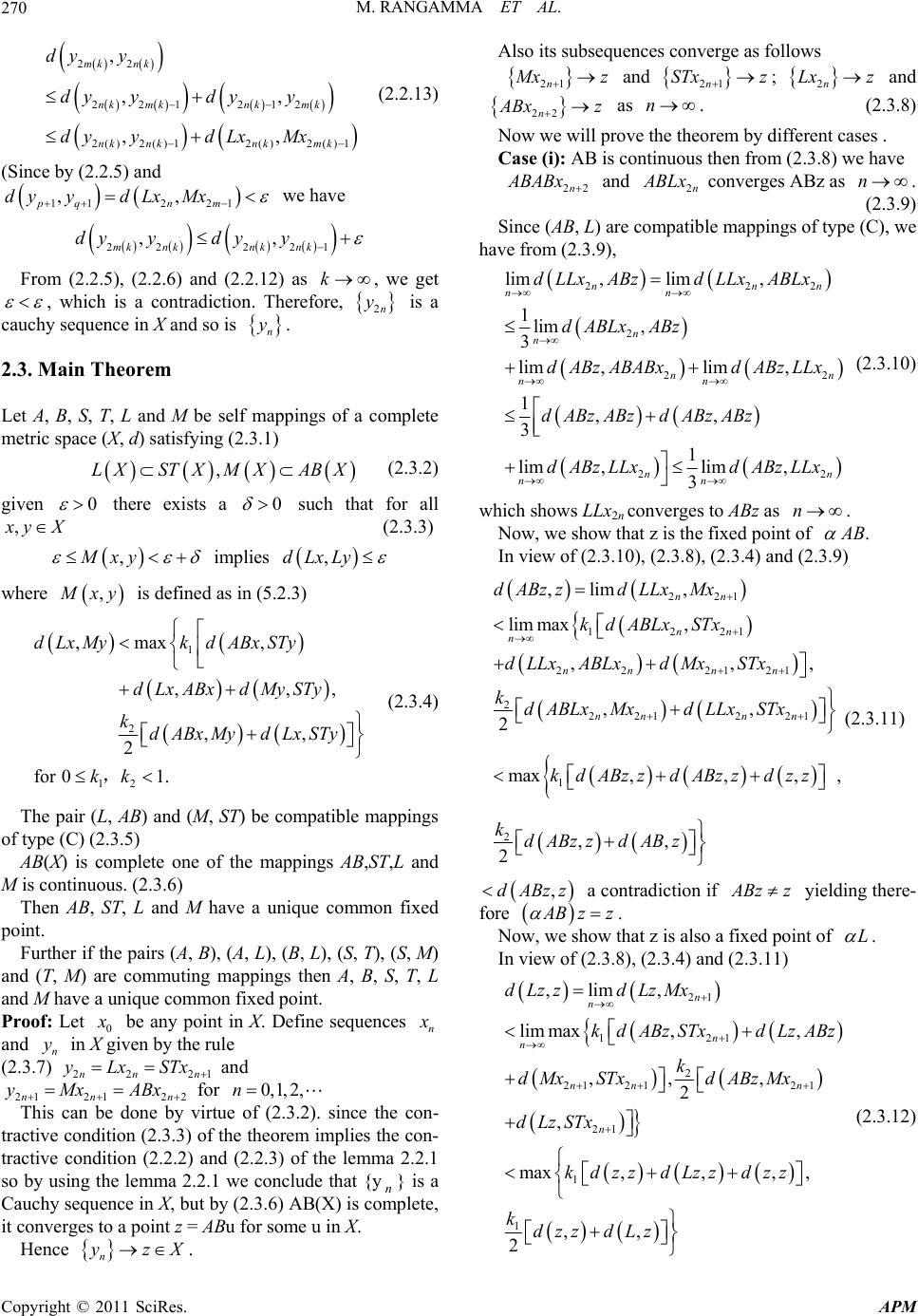 M. RANGAMMA ET AL. 270 22 221 212 2()2()12()2 ()1 , ,, ,, mk nk nk mknkmk nk nknkmk dy y dy ydyy dyydLxMx (2.2.13) (Since by (2.2.5) and 112 21 ,, pqn m dyydLxMx we have 22 221 ,, mk nknk nk dyydy y From (2.2.5), (2.2.6) and (2.2.12) as , we get k , which is a contradiction. Therefore, n2 y is a cauchy sequence in X and so is n y . 2.3. Main Theorem Let A, B, S, T, L and M be self mappings of a complete metric space (X, d) satisfying (2.3.1) ,LXSTXM XABX (2.3.2) given 0 there exists a 0 such that for all , x yX (2.3.3) ,Mxy implies ,dLxLy where , M xy is defined as in (5.2.3) 1 2 12 ,max , ,,, ,, 2 for 01. dLxMyk dABxSTy dLxABxdMy STy kdABx MydLx STy kk , (2.3.4) The pair (L, AB) and (M, ST ) be compatible mappings of type (C) (2.3.5) AB(X) is complete one of the mappings AB,ST,L and M is continuous. (2.3.6) Then AB, ST, L and M have a unique common fixed point. Further if the pairs (A, B), (A, L), (B, L), (S, T), (S, M) and (T, M) are commuting mappings then A, B, S, T, L and M have a unique common fixed point. Proof: Let 0 x be any point in X. Define sequences n x and in X given by the rule n (2.3.7) 1 and y 22 2nn xSTx yMxABxn for yL 21 2122nn n This can be done by virtue of (2.3.2). since the con- tractive condition (2.3.3) of the theorem implies the con- tractive condition (2.2.2) and (2.2.3) of the lemma 2.2.1 so by using the lemma 2.2.1 we conclude that {yn} is a Cauchy sequence in X, but by (2.3.6) AB(X) is complete, it converges to a point z = ABu for some u in X. 0,1,2,n Hence n y zX. Also its subsequences converge as follows 21n M xz and 21n STxz ; and 2n Lx z 22n A Bx z as . (2.3.8) n Now we will prove the theorem by different cases . Case (i): AB is continuous then from (2.3.8) we have 22n A BABx and 2n A BLx converges ABz as . (2.3.9) n Since (AB, L) are compatible mappings of type (C), we have from (2.3.9), 22 2 22 22 lim,lim, 1lim , 3 lim, lim, 1,, 3 1 lim, lim, 3 nn nn n n nn nn nn nn d LLxABzd LLxABLx d ABLxABz dABzABABxdABz LLx dABz ABzdABz ABz dABzLLxdABzLLx 2n (2.3.10) which shows LLx2n converges to ABz as . n Now, we show that z is the fixed point of AB. In view of (2.3.10), (2.3.8), (2.3.4) and (2.3.9) 221 1221 22 2121 2 2212 21 1 2 ,lim , lim max, ,, ,, 2 max,,, , ,, 2 nn nn n nn nn nnn n dABzzdLLx Mx kd ABLxSTx d LLxABLxd MxSTx kdABLxMx dLLxSTx kdABzzd ABzzdzz kdABzz dABz , (2.3.11) ,dABz z a contradiction if A Bz z yielding there- fore A Bz z . Now, we show that z is also a fixed point of L . In view of (2.3.8), (2.3.4) and (2.3.11) 21 121 2 212121 21 1 1 ,lim , lim max,, ,, , 2 , max,,, , ,, 2 n n n n nn n n dLzz dLzMx kdABz STxdLzABz k dMx STxdABzMx dLzSTx kdzzdLzzd zz kdzz dLz (2.3.12) Copyright © 2011 SciRes. APM 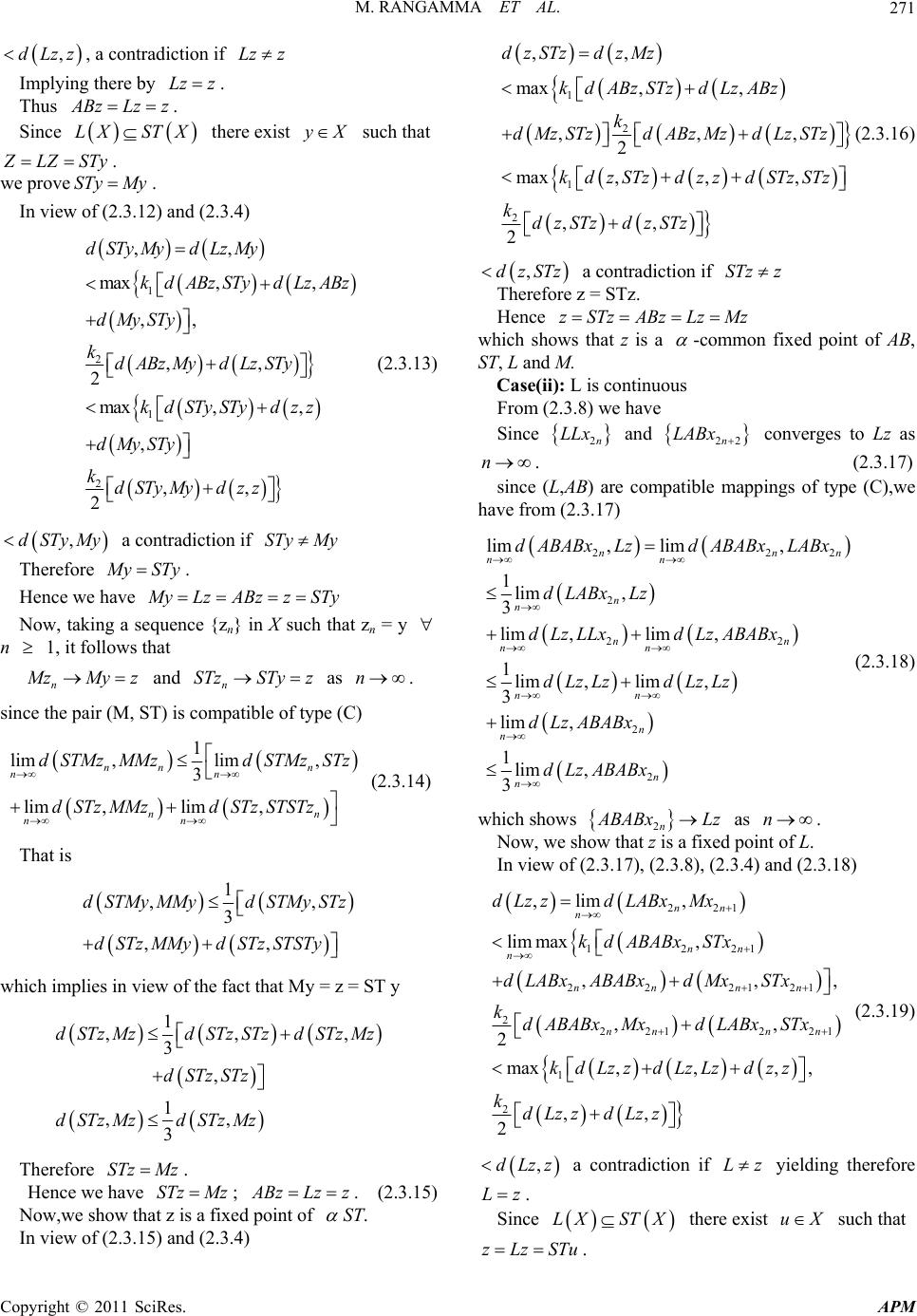 M. RANGAMMA ET AL.271 ,dLzz, a contradiction if Lz z Implying there by . Lz z Thus A Bz Lz z. Since there exist LX STX y X such that Z LZ STy STy . we prove. My In view of (2.3.12) and (2.3.4) 1 2 1 2 ,, max ,, ,, ,, 2 max, , , ,, 2 dSTyMydLzMy kdABzSTy dLzABz dMySTy kdABzMy dLzSTy kdSTySTy dzz dMySTy kdSTyMydzz (2.3.13) ,dSTyMy a contradiction if STy My Therefore M ySTy. Hence we have M yLzABzzSTy Now, taking a sequence {zn} in X such that zn = y n 1, it follows that n M zMyz and as n. n STzSTy z since the pair (M, ST) is compatible of type (C) 1 lim ,lim , 3 lim ,lim , nn n nn nn nn d STMzMMzdSTMzSTz dSTz MMzdSTz STSTz (2.3.14) That is 1 ,, 3 ,, dSTMyMMy dSTMySTz dSTz MMydSTz STSTy which implies in view of the fact that My = z = ST y 1 ,, 3 , 1 ,, 3 dSTzMzdSTzSTz dSTzMz dSTzSTz dSTzMz dSTzMz , Therefore . STz Mz Hence we have ; STz Mz A Bz Lz z . (2.3.15) Now,we show that z is a fixed point of ST. In view of (2.3.15) and (2.3.4) 1 2 1 2 ,, max ,, ,, 2 max ,,, ,, 2 dzSTz dzMz kdABzSTz dLzABz k dMz STzdABz MzdLz STz kdzSTz dzz dSTzSTz kdzSTz dzSTz , (2.3.16) ,dzSTz a contradiction if STz z Therefore z = STz. Hence zSTzABzLzMz which shows that z is a -common fixed point of AB, ST, L and M. Case(ii): L is continuous From (2.3.8) we have Since 2n LLx and 22n LABx converges to Lz as . (2.3.17) n since (L,AB) are compatible mappings of type (C),we have from (2.3.17) 22 2 22 2 2 lim,lim, 1lim , 3 lim ,lim , 1lim ,lim, 3 lim , 1lim , 3 nn nn n n nn nn nn n n n n dABABx LzdABABx LABx d LABxLz dLzLLx dLzABABx dLzLz dLzLz dLz ABABx dLz ABABx 2n (2.3.18) which shows 2n A BABx Lz as . n Now, we show that z is a fixed point of L. In view of (2.3.17), (2.3.8), (2.3.4) and (2.3.18) 221 1221 222121 2 2212 21 1 2 ,lim , lim max, ,, ,, 2 max,,, , ,, 2 nn n nn n nn nn nnn n dLzzdLABx Mx kd ABABxSTx d LABxABABxdMxSTx kdABABxMxd LABxSTx kdLz zdLzLzdz z kd Lzzd Lzz , (2.3.19) ,dLzz Lz a contradiction if yielding therefore Lz . Since LX STX there exist u such that X zLzSTu . Copyright © 2011 SciRes. APM 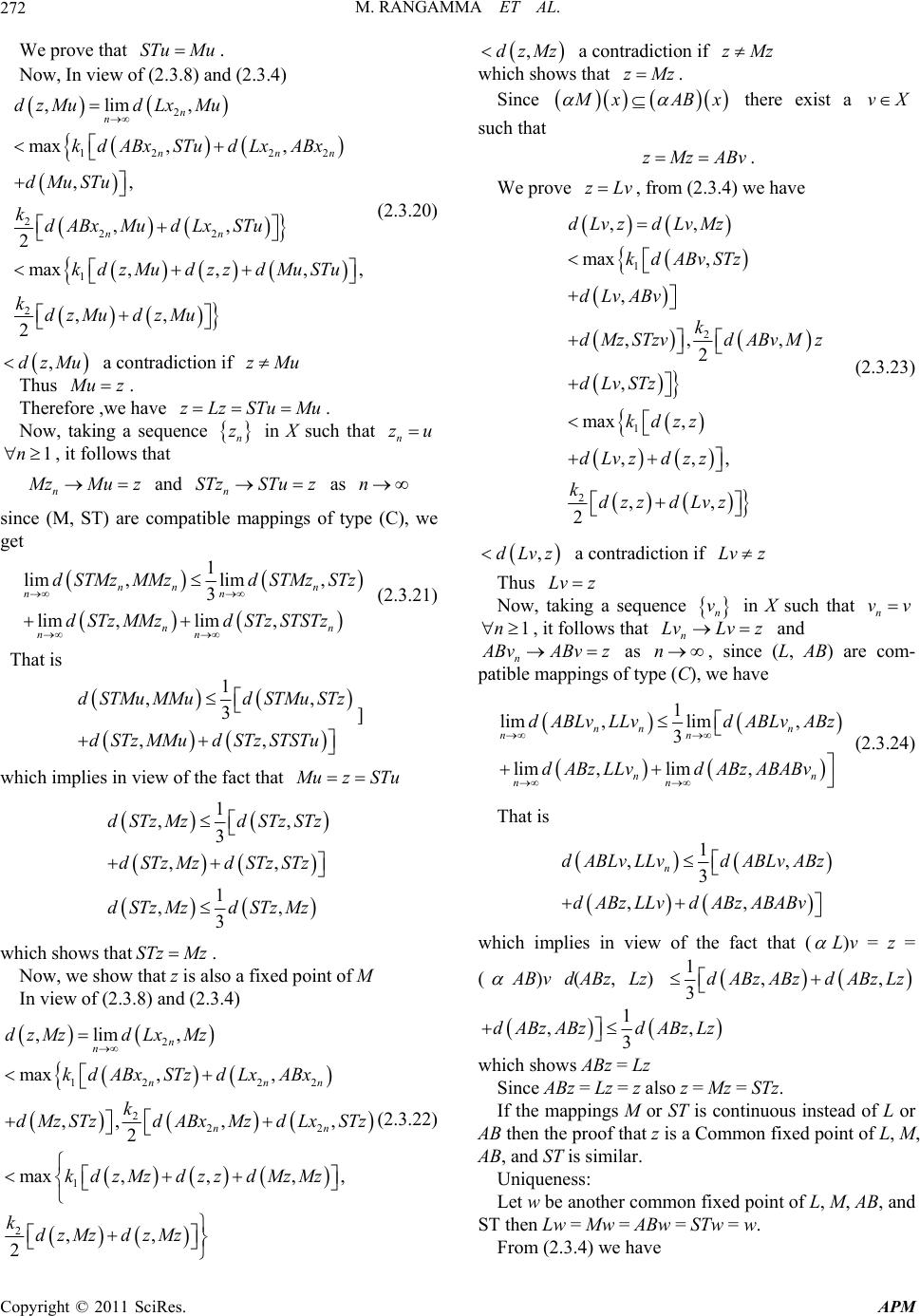 M. RANGAMMA ET AL. 272 We prove that . STu Mu Now, In view of (2.3.8) and (2.3.4) 2 12 22 2 22 1 2 ,lim , max ,, ,, ,, 2 max,,, , ,, 2 n n nn nn dzMudLx Mu kdABx STudLx ABx dMuSTu kd ABxMud LxSTu kdzMu dzz dMuSTu kdzMu dzMu n (2.3.20) ,dzMu a contradiction if zMu Thus M uz. Therefore ,we have . zLzSTuMu Now, taking a sequence in X such that n zn zu , it follows that 1n n M zMuz and as n STzSTu z n since (M, ST) are compatible mappings of type (C), we get 1 lim ,lim , 3 lim ,lim , nn n nn nn nn dSTMzMMzdSTMzSTz dSTz MMzdSTz STSTz (2.3.21) That is 1 ,, 3 ,, dSTMu MMudSTMu STz dSTz MMudSTz STSTu ] which implies in view of the fact that M uzSTu 1 ,, 3 ,, 1 ,, 3 dSTzMzdSTzSTz dSTzMzdSTzSTz dSTzMzdSTzMz which shows that. STz Mz Now, we show that z is also a fixed point of M In view of (2.3.8) and (2.3.4) ,dzMz a contradiction if zMz which shows that zMz . Since M xAB x there exist a vX such that zMzABv . We prove zLv , from (2.3.4) we have 1 2 1 2 ,, max , , ,, , 2 , max , ,,, ,, 2 dLvz dLvMz kdABvSTz dLvABv k dMzSTzv dABvMz dLvSTz kdzz dLvz dzz kdzz dLvz (2.3.23) ,dLvz a contradiction if Lvz Thus Lvz Now, taking a sequence n v in X such that n vv 1n , it follows that and n n Lv zLv A BvABv z as , since (L, AB) are com- patible mappings of type (C), we have n 1 lim ,lim, 3 lim ,lim , nn n nn nn nn d ABLvLLvd ABLvABz d ABzLLvdABzABABv (2.3.24) That is 1 ,, 3 ,, n dABLv LLvdABLv ABz dABz LLvdABz ABABv which implies in view of the fact that ( L)v = z = ( AB)v d(ABz, Lz) 1,, 3dABz ABz ABz Lz d 1 ,, 3 d ABzABzdABzLz 2 12 22 2 22 1 2 ,lim , max ,, ,, ,, 2 max,,, ,, 2 n n nnn nn dzMzdLx Mz kdABx STzdLxABx k dMzSTzdABx MzdLx STz kd zMzdzzdMzMz kdzMz dzMz which shows ABz = Lz Since ABz = Lz = z also z = Mz = STz. , (2.3.22) If the mappings M or ST is continuous instead of L or AB then the proof that z is a Common fixed point of L, M, AB, and ST is similar. Uniqueness: Let w be another common fixed point of L, M, AB, and ST then Lw = Mw = ABw = STw = w. From (2.3.4) we have Copyright © 2011 SciRes. APM  M. RANGAMMA ET AL. Copyright © 2011 SciRes. APM 273 1 2 1 2 ,, max ,, ,,, 2 , max,,, , ,, 2 dzwdLzMw kdABzSTw dLzABz k dMwSTwdABzMw dLzSTw kdzw dzzdww kdzwdzw (2.3.25) Let 1 1 n xn for 1n Then as . 1 n xn ,0 iff 1 nn n dABLxLLx x ,0 iff nn d ABLxABtx1 ,0 iff dABt ABABxx1 nn ,0 iff dABt LLxx1 n nn , ,, nnn A Bx STx n Lx Mxt converges to 1 as . X The pairs (L, AB) and (M, ST) are compatible map- pings of type (c) and also satisfies the conditions (2.3.2), (2.3.3), (2.3.4), (2.3.5) and (2.3.6) ,dzw a contradiction if zw yielding there by z w. Remarks: Main theorem remains true if we replace condition compatible mappings of type (C) by Finally we need to show that z is a common fixed point of L, M, A, B, S and T. 1) compatible mappings of type (A) or For this let z is the unique common fixed point of (AB, L) and (ST, M). 2) compatible mappings of type (B) or 3) compatible mappings of type (P) Since (A, B), (A, L), (B, L) are commutative ; A zAABzA BAzABAzAzALzLAz 3. References ;Bz BABzBABzABAzBz BLz LBz . [1] K. Jha, R. P. Pant and S. L. Singh, “On the Existence of Common Fixed Point for Compatible Mappings,” Journal of Mathematics, Vol. 37, 2005, pp. 39-48. which shows that Az, Bz are common fixed points of (AB, L) yielding there by A z Z Bz LzABz in the view of uniqueness of common fixed point of the pairs (AB, L) . [2] R. P. Pant, P. C. Joshi and V. Gupta, “A Meir-Keelar Type Fixed Point Theorem,” Indian Journal of Pure & Applied Mathematics, Vol. 32, No. 6, 2001, pp. 779-787. Similarly using the, commutativity of (S,T), (S,M) and (T,M) it can be shown that Sz = z = Tz = Mz = STz. [3] R. P. Pant, “A Common Fixed Point Theorem for Two Pairs of Maps Satisfying the Condition (E.A),” Journal of Physical Sciences, Vol. 16, No. 12, 2002, pp. 77-84. Now, we need to show that Az = Sz (Bz = Tz) also re- mains a common fixed point of both the pairs (AB, L) and (ST, M). [4] G. Jungck, “Compatible Mappings and Common Fixed Points,” International Journal of Mathematics and Mathe- matical Sciences, Vol. 9, 1986, pp. 771-779. From (2.3.4) we have 1 2 1 2 ,, max ,, ,, ,, 2 max,,,, ,,0 2 dAzSz dLzMz kdABz STzdLzABz k dMzSTzdABzMzdLzSTz kd zzd zzdzz kdzz dzz [5] G. Jungck, P. P. Murthy and Y. J. cho, “Compatible Map- pings of Type(A) and Common Fixed Point Theorems,” Mathematica Japonica, Vol. 38, No. 2, 1993 pp. 381-390. [6] H. K. Pathak and M. S. Khan, “Compatible Mappings of Type (B) and Common Fixed Point Theorems of Gregus Type,” Czechoslovak Mathematical Journal, Vol. 45, No. 120, 1995, pp. 685-698 [7] H. K. Pathak, Y. J. cho, S. M. Kang and B. Madharia, “Compatible Mappings of Type (C) and Common Fixed Point Theorems of Gergus Type,” Demonstratio Mathe- matica, Vol. 31, No. 3, 1998, pp. 499-518. implies that Az = Sz. [8] H. K. Pathak, Y. J. Cho, S. S. Chang, et al., “Compatible Mappings of Type (P) and Fixed Point Theorem in Metric Spaces and Probabilistic Metric Spaces,” Novisad. Jour- nal of Mathematics, Vol. 26, No. 2, 1996, pp. 87-109. similarly it can be shown that Bz = Tz. Thus z is the unique common fixed point of A, B, S, T, L and M. This establishes the theorem. Now we give an example to claim our result. [9] J. Jachymski, “Common Fixed Point Theorem for Some Families of Mappings,” Indian Journal of Pure & Ap- plied Mathematics, Vol. 25, 1994, pp. 925-937. Example: Let 1,X with ,dxyxy. De- fine self maps A, B, S, T, L and : M XX by Lx x , 2 M xx, , 2 21xSTAB 4 21x 1, x |

